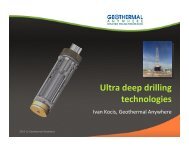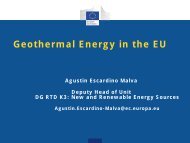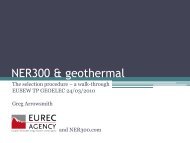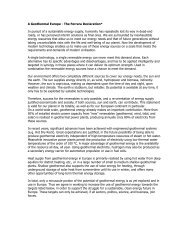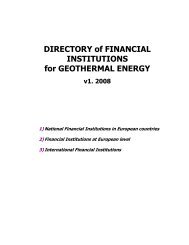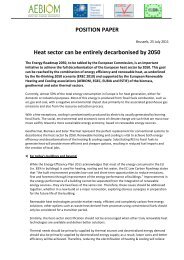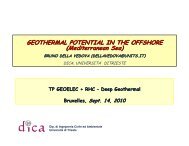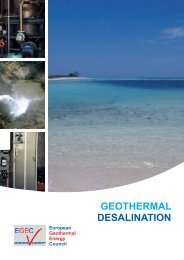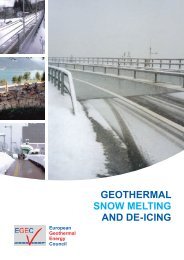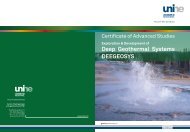Strategic Research and Innovation Agenda for Renewable ... - EGEC
Strategic Research and Innovation Agenda for Renewable ... - EGEC
Strategic Research and Innovation Agenda for Renewable ... - EGEC
Create successful ePaper yourself
Turn your PDF publications into a flip-book with our unique Google optimized e-Paper software.
<strong>Renewable</strong>Heating & CoolingEuropean Technology Plat<strong>for</strong>mAppendix 8List of FiguresFigure A: Estimated distribution of resources by type of activity, distinguishing between priorities with impactin the short-term <strong>and</strong> medium- to long-term.............................................................................................................. iiiFigure B: Estimation of total resources required to implement the RHC-SRA between 2014 <strong>and</strong> 2020,in million Euro <strong>and</strong> in % by sector. ................................................................................................................................ iiiFigure C: Clusters of key research <strong>and</strong> innovation areas by technology type............................................................................vFigure 1: Structure of the RHC-Plat<strong>for</strong>m....................................................................................................................................... 2Figure 2: Final energy use in EU-27 by type of energy <strong>and</strong> final energy use <strong>for</strong> heat by individual sector <strong>for</strong> the year 2010...... 6Figure 3: Heating <strong>and</strong> cooling supply in the EU-27 (2004-2010).................................................................................................. 7Figure 4: Projections of heating <strong>and</strong> cooling dem<strong>and</strong> in the EU.................................................................................................. 8Figure 5: Heating supply from renewable energy sources in EU................................................................................................ 9Figure 6: Heating potential by renewable energy sources in EU................................................................................................ 9Figure 7: Modelling of heat consumption <strong>and</strong> supply until 2020: interlink between the Common Vision <strong>and</strong> the NREAPs..... 10Figure 8: Scale of Technology Readiness Levels adopted by the RHC-Plat<strong>for</strong>m................................................................... 12Figure 9: Comparison of heat costs between different solar thermal applications in different regions <strong>and</strong> costs ofuseful heat from electricity <strong>and</strong> natural gas............................................................................................................... 15Figure 10: Collector production costs <strong>and</strong> market evolution from 1995 until 2020................................................................. 16Figure 11: Full load type testing results of biomass boilers according to EN 303-5 over time.............................................. 19Figure 12: Micro-CHP installations in Europe from 1990-2008.................................................................................................. 21Figure 13: Market potential of micro CHPs in Europe. Source: COGEN Europe (2010)............................................................ 21Figure 14: Increase in efficiency of geothermal heat pumps, shown through the seasonal Coefficientof Per<strong>for</strong>mance (sCOP) of state-of-the-art systems, <strong>and</strong> efficiency increase of heat transferin state-of-the-art borehole heat exchangers, expressed as Hellström-Efficiency ηH...................................... 25Figure 15: Development of specific cost <strong>for</strong> BHE (i.e. a unit of BHE length) <strong>and</strong> of required BHE length in Central Europe...... 26Figure 16: Development of system first cost, heat full cost, <strong>and</strong> electricity consumption of geothermalheat pump systems in the residential sector in Central Europe.............................................................................. 26Figure 17: Trend <strong>and</strong> potential efficiency evolution of sCOP <strong>for</strong> electrically driven air to water heat pumps in heatingmode. Per<strong>for</strong>mance described by the seasonal Coefficien Of Per<strong>for</strong>mance (sCOP)............................................ 28Figure 18: Trend <strong>and</strong> potential efficiency evolution of thermally driven sorption heat pumps in heating mode.Per<strong>for</strong>mance described by the seasonal Gas Utilisation Efficiency (sGUE), equivalent to primaryenergy ratio...................................................................................................................................................................... 29Figure 19: Potential improvements by 2020 in terms of costs <strong>and</strong> per<strong>for</strong>mance, expressed relative to 2010..................... 29Figure 20: Cost reduction of installed hybrid systems combining solar thermal <strong>and</strong> sorption chillers(also known as solar cooling systems)........................................................................................................................ 30Figure 21: Small-scale hybrid system composed of biomass boiler, solar thermal collector<strong>and</strong> sensible thermal energy storage ......................................................................................................................... 31Figure 22: Example of an integrated <strong>and</strong> prefabricated hybrid system combining solar thermal collectors<strong>and</strong> an air source heat pump <strong>for</strong> delivery of heating <strong>and</strong> domestic hot water to single family houses............... 31Figure 23: The most frequently used options <strong>for</strong> storage of large amounts of sensible heat, in liquid (water)or solid (soil, rock) matter.............................................................................................................................................. 32Figure 24: Development of specific cost <strong>for</strong> BHE in Central Europe <strong>and</strong> reduction of borehole thermalresistance (i.e. efficiency increase of heat transfer) in state-of-the-art BHE; these improvedirectly BTES efficiency <strong>and</strong> economy......................................................................................................................... 33Figure 25: Potential efficiency evolution of phase change materials (in kJ/kg)........................................................................ 33Figure 26: Potential storage density evolution of thermochemical materials <strong>for</strong> seasonal storageof renewable heat (in kWh/m 3 )...................................................................................................................................... 34Figure 27: Characteristics of various thermal energy storage technologies (range of values)<strong>and</strong> expected evolution between 2011 <strong>and</strong> 2020......................................................................................................... 34Figure 28: Potential evolution of capital costs <strong>for</strong> biomass heat plants.................................................................................... 44Figure 29: Biomass heat production costs in 2010 <strong>and</strong> 2020....................................................................................................... 44Figure 30: Industrial heat dem<strong>and</strong> by temperature level in the EU in 2010 <strong>and</strong> industrial heat dem<strong>and</strong>in the EU in 2010 <strong>and</strong> expected dem<strong>and</strong> in 2050......................................................................................................... 51Figure 31: Industrial heat dem<strong>and</strong> by temperature level <strong>and</strong> industrial sector....................................................................... 52Figure 32: <strong>Renewable</strong> energy supply technologies which meet the requirements of heat dem<strong>and</strong> <strong>for</strong> industrialprocesses at different temperature levels. Concentrated solar thermal is not included.................................... 52Figure 33: Investment costs related to different large-scale conversion technologies......................................................... 53Figure 34: Heat pump technologies <strong>and</strong> their operating temperatures.................................................................................... 57Figure 35: Share of renewable energy in DHC............................................................................................................................... 61Figure 36: In time, lower <strong>and</strong>/or more flexible temperatures will be used in the distribution networksFigure 37: The transition to Smart Cities <strong>and</strong> the development of DHC are positively related............................................... 62Figure 38: Potential evolution of costs <strong>for</strong> renewable DHC......................................................................................................... 63Figure 39: Market potential of renewable DHC in Europe............................................................................................................ 63Figure 40: Marginal distribution costs <strong>and</strong> corresponding urban district heating heat marketpenetration in fourEuropean countries in 2008.......................................................................................................... 64Figure 41: Projected evolution of biomass <strong>and</strong> biogas CHP plants connected to DHC............................................................ 65Figure 42: Cost of heat from an active flue gas condensation system in a 10 MW fuel input district heatingplant retrofitted with a 170 kW heat pump <strong>for</strong> different flue gas temperatures.................................................... 66Figure 43: Schematic view of a heat cascading network.............................................................................................................. 69Figure 44: Funding <strong>for</strong> energy research under FP7 <strong>and</strong> final energy consumption by sector................................................ 84Figure 45: Estimation of total resources required to implement the RHC-Plat<strong>for</strong>m’s SRA between 2014 <strong>and</strong> 2020,in million Euro <strong>and</strong> in %.................................................................................................................................................. 87101



